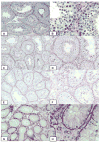Suppression of spermatogenesis by bisdichloroacetyldiamines is mediated by inhibition of testicular retinoic acid biosynthesis
- PMID: 20705791
- PMCID: PMC3370679
- DOI: 10.2164/jandrol.110.010751
Suppression of spermatogenesis by bisdichloroacetyldiamines is mediated by inhibition of testicular retinoic acid biosynthesis
Abstract
The bisdichloroacetyldiamine WIN 18,446 reversibly inhibits spermatogenesis in many species, including humans; however, the mechanism by which WIN 18,446 functions is unknown. As retinoic acid is essential for spermatogenesis, we hypothesized that WIN 18,446 might inhibit retinoic acid biosynthesis from retinol (vitamin A) within the testes by inhibiting the enzyme aldehyde dehydrogenase 1a2 (ALDH1a2). We studied the effect of WIN 18,446 on ALDH1a2 enzyme activity in vitro, and on spermatogenesis and fertility in vivo, in mature male rabbits for 16 weeks. WIN 18,446 markedly inhibited ALDH1a2 enzyme activity in vitro with an IC(50) of 0.3 μM. In vivo, the oral administration of 200 mg/kg WIN 18,446 to male rabbits for 16 weeks significantly reduced intratesticular concentrations of retinoic acid, severely impaired spermatogenesis, and caused infertility. Reduced concentrations of intratesticular retinoic acid were apparent after only 4 weeks of treatment and preceded the decrease in sperm counts and the loss of mature germ cells in tissue samples. Sperm counts and fertility recovered after treatment was discontinued. These findings demonstrate that bisdichloroacetyldiamines such as WIN 18,446 reversibly suppress spermatogenesis via inhibition of testicular retinoic acid biosynthesis by ALDH1a2. These findings suggest that ALDH1a2 is a promising target for the development of a reversible, nonhormonal male contraceptive.
Figures





References
-
- Asa C, Zaneveld LJD, Munson L, Callahan M, Byers AP. Efficacy, safety and reversibility of a bisdiamine male-directed oral contraceptive in grey wolves (Canis lupus) J Zoo Wildl Med. 1996;27:501–506.
-
- Berberian DA, Slighter RG, Surrey AR. In vitro and in vivo amebicidal activity of N, N′Bis(dichloroacetyl)diamines. Antibiot Chemother. 1961;11:245–255.
-
- Beyler AL, Potts GO, Coulston F, Surrey AR. The selective testicular effects of certain bis-(dichloroacetyl) diamines. Endocrinology. 1961;69:819–833.
-
- Bishop PD, Griswold MD. Uptake and metabolism of retinol in cultured Sertoli cells: evidence for a kinetic model. Biochemistry. 1987;26:7511–7518. - PubMed
Publication types
MeSH terms
Substances
Grants and funding
LinkOut - more resources
Full Text Sources
Other Literature Sources
Research Materials
Miscellaneous
